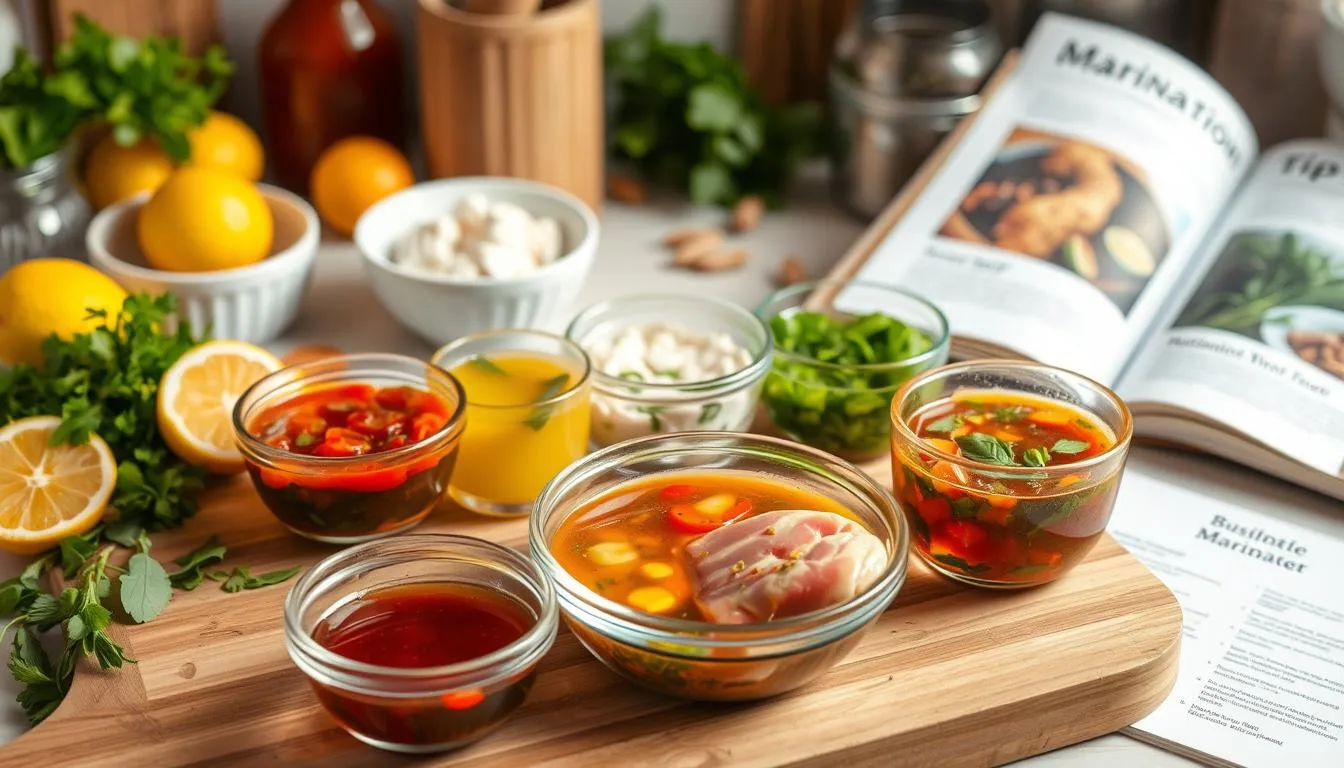how to marinate effectively ? Do you remember that bland chicken dinner that left you disappointed? Learning how to marinate can change your cooking game. Marinating techniques are not just a trick. They’re your secret to making simple ingredients taste amazing.
Whether you cook at home or dream of being a chef, knowing marinading techniques can change your kitchen game. With a few simple ingredients and the right method, you can add depth and complexity to any dish.
Marination is more than just soaking food in liquid. It’s an art that balances acids, oils, and seasonings. This enhances flavor, tenderizes proteins, and makes meals unforgettable. From chicken and beef to seafood and veggies, mastering marinades will boost your cooking skills.
Exploring different marinading techniques can unlock rich flavors and tender textures. You’ll impress your family and friends with dishes that taste like they’re from a restaurant. Get ready to make your meals unforgettable!
Understanding the Science Behind Marination
Marination is a mix of art and science that turns regular meat into amazing dishes. It’s not just about adding flavor. It’s about changing the meat’s structure through chemical reactions.
The Protein-Breaking Power of Acids
Acids do magic when added to meat. They break down proteins, making the meat tender and flavorful. Common acids include:
- Citrus juices (lemon, lime)
- Vinegar
- Wine
- Yogurt
Salt’s Moisture Management Magic
Salt is key in marination. It pulls moisture from the meat, allowing flavors to soak in. This keeps the meat juicy and seasoned. Studies show marinating for 1-8 hours improves moisture.
“Salt is the secret weapon in transforming ordinary meat into a culinary masterpiece.” – Chef Michael Rodriguez
Fat’s Flavor Distribution Mechanism
Fats carry flavors in marination, spreading them evenly. Oils like olive and vegetable oil add taste and prevent drying during cooking.
Knowing these science facts can make your cooking better. It turns simple ingredients into gourmet meals by tenderizing and infusing flavors.
Essential Components of a Perfect Marinade
To make amazing marinades, you need to know the main ingredients. These ingredients turn simple dishes into works of art. The key is to mix acid, fat, and seasonings just right.
- Acidic Ingredients: These break down proteins and add a tangy taste
- Citrus juices (lemon, lime, orange)
- Vinegars
- Wine
- Buttermilk
- Fat Components: They spread flavors and tenderize
- Olive oil
- Vegetable oil
- Sesame oil
- Coconut oil
- Seasonings: They boost the taste
- Fresh herbs
- Dried spices
- Garlic
- Salt
“The secret to an extraordinary marinade lies in perfectly balanced acidic ingredients and complementary flavors.” – Professional Chef
When making marinades, use 3 parts fat to 1 part acid. This mix helps flavors soak in well without covering up the protein’s taste.
| Protein Type | Recommended Marination Time | Key Acidic Ingredients |
|---|---|---|
| Chicken | 5-6 hours | Lemon juice, Vinegar |
| Beef | 12-24 hours | Red wine, Balsamic vinegar |
| Pork | 1-24 hours | Apple cider vinegar, Citrus |
| Fish | 10-15 minutes | Lime juice, White wine |
Getting the balance right is crucial. Too much acid can make things taste pickled. Too much salt can overwhelm the dish’s natural flavors.
How to Marinate Effectively
Learning how to marinate well is all about mastering certain techniques and following best practices. The right containers and food safety rules can make your cooking stand out. It goes from good to great.
Selecting the Perfect Marinating Containers
The container you choose is key in food preparation. Here are some top picks:
- Glass or ceramic dishes with tight-fitting lids
- Food-grade plastic containers
- Resealable plastic bags
- Stainless steel containers
“The right container can make all the difference in your marination process.”
Temperature Control Guidelines
Keeping the right temperature is vital for safety and flavor. Always marinate in the fridge, keeping food under 40°F to stop bacteria.
Each protein needs a different marinating time:
- Fish and seafood: 15-30 minutes
- Chicken: 2 hours
- Pork or beef: Up to 12 hours
Food Safety Considerations
Follow these key food safety tips when marinating:
- Never reuse marinades that have touched raw meat
- Always discard used marinades or boil them for one minute if you want to use as a sauce
- Use approximately ½ cup of marinade per pound of meat
- Pat meat dry before cooking to enhance browning
By using these tips, you’ll boost your cooking skills and make tasty, safe meals every time.
Selecting the Right Acidic Ingredients
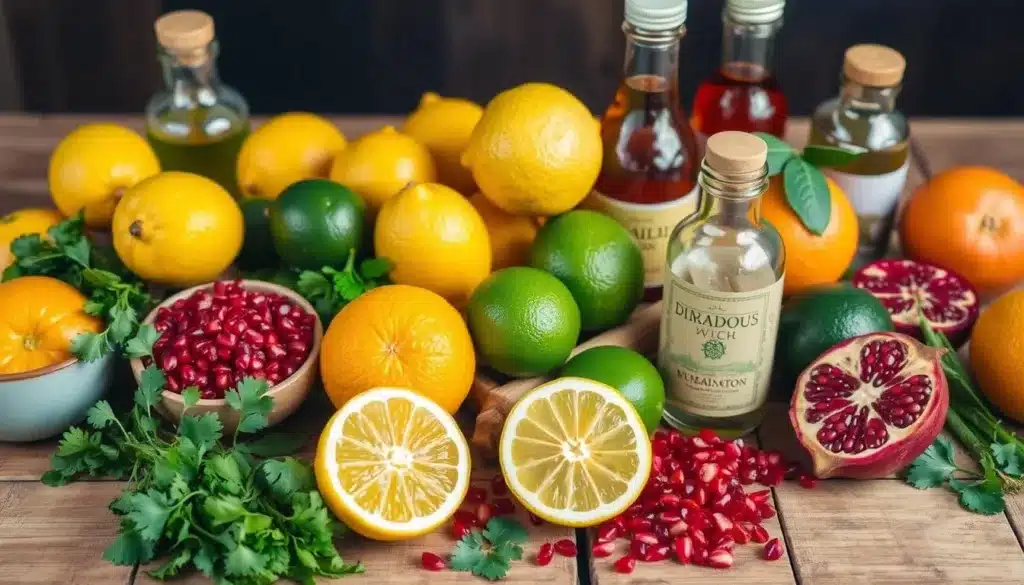
Mastering marinading techniques means knowing the power of acidic ingredients. Not all acids are the same when it comes to tasty meals. Your choice of acidic ingredients can change the flavor and texture of your proteins a lot.
Exploring acidic ingredients, you’ll find several key players in marinading:
- Citrus juices (lemon, lime, orange)
- Vinegars (apple cider, red wine, balsamic)
- Dairy products (yogurt, buttermilk)
- Wine
“The right acid can elevate a simple dish from ordinary to extraordinary.” – Professional Chef’s Insight
It’s important to understand the science behind acidic ingredients. They do more than add tang – they break down protein fibers. This makes dishes more tender and flavorful. Marinading techniques need a careful balance to avoid over-tenderizing.
When picking acidic ingredients, consider a few things:
- What protein you’re marinating
- The flavor you want
- How long you’ll marinate
- How you’ll cook it
Pro tip: Use citrus juices for seafood and chicken, and vinegars for red meats. Dairy acids like yogurt are great for tenderizing lamb and poultry.
Remember, too much acid can make your protein mushy. Aim for a balance that boosts flavor without overpowering it.
Oil and Fat Ratios for Different Foods
Learning about oil and fat ratios is key to making tasty marinades. The right mix of oils can make your food moist, flavorful, and perfectly cooked.
To make great marinades, knowing the best oil-to-ingredient ratio is vital. A classic rule is:
- 1 part acid
- 3 parts fat or oil
- Seasonings to taste
Best Oils for Marinating
Each oil adds its own special touch to marinades. Here are some favorites:
- Olive Oil: Rich flavor, perfect for Mediterranean dishes
- Sesame Oil: Strong nutty taste, ideal for Asian marinades
- Vegetable Oil: Neutral taste, suits most recipes
Balancing Oil with Other Ingredients
Finding the right oil and fat mix depends on the protein. A good rule is to use 1/2 cup of marinade for every pound of meat.
“The secret to a perfect marinade is balance – not too oily, not too acidic.”
Fat Content Considerations
Fat helps spread flavors and keeps meat moist. Here are some tips:
- Leaner meats need more fat
- Fatty cuts need less oil
- Change oil ratios based on cooking method
By mastering these marinading techniques, you’ll improve your cooking skills. You’ll make dishes that taste like they’re from a restaurant.
Time Guidelines for Different Proteins
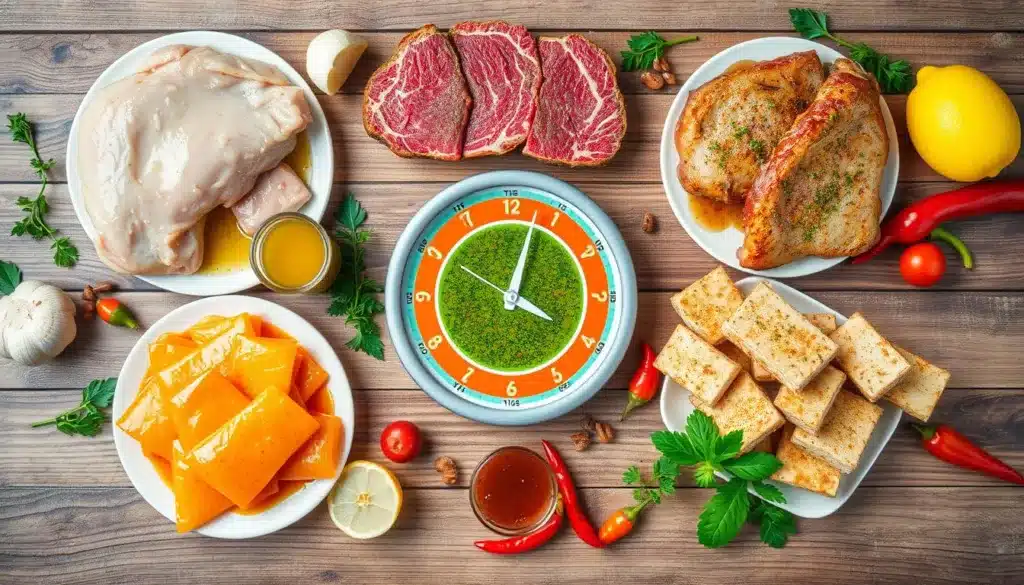
Learning how to marinate is key to making tasty meals. Each protein needs a specific marinating time. This ensures the best flavor and tenderness without making the meat tough.
Here are some guidelines for marinating times based on protein type:
- Fish and seafood: 15-30 minutes
- Chicken: About 2 hours
- Pork or beef: Up to 12 hours
Pro tip: Overnight marination often yields the most flavorful results.
“The magic of marination lies in understanding each protein’s unique characteristics.” – Culinary Expert
Marinating safely is important. Keep these tips in mind:
- Marinade only goes a few millimeters into the meat
- Don’t marinate too long to avoid tough meat
- Always marinate in the fridge to keep food safe
| Protein Type | Recommended Marinating Time | Key Considerations |
|---|---|---|
| Fish/Seafood | 15-30 minutes | Delicate proteins can break down quickly |
| Chicken | 2 hours | Absorbs flavors well without becoming mushy |
| Beef/Pork | 4-12 hours | Longer marination enhances tenderness |
Remember, ingredients like pineapple juice can quickly break down proteins. Use them carefully to keep the meat’s texture right.
Flavor Enhancement Techniques
To make your marinades better, learn about flavor infusion. It’s not just about adding spices. It’s about making dishes that stand out.
Professional chefs use a special trick called flavor layering. They mix herbs, spices, and aromatics to make food taste amazing.
Mastering Herb and Spice Combinations
Good flavor infusion comes from knowing which ingredients go well together. Here are some great pairs:
- Rosemary and garlic for robust red meats
- Thyme and lemon for poultry
- Ginger and soy sauce for Asian-inspired dishes
Building Flavor Layers Strategically
To add depth to your marinades, think about how ingredients work together. Salt softens meat, acids make it tender, and fats spread flavors.
| Ingredient Type | Flavor Function | Recommended Quantity |
|---|---|---|
| Salt | Fiber breakdown | 1-2% of meat weight |
| Acid | Protein tenderization | Equal parts with oil |
| Fat | Flavor distribution | Neutral oils preferred |
Selecting Perfect Aromatics
Aromatics are key to great flavor. Bruising herbs and smashing garlic cloves makes your marinade stronger.
The key to an exceptional marinade is balance – no single ingredient should overpower the others.
Don’t be afraid to try new things and listen to your taste. Every marinade is a chance to make something special.
Common Marination Mistakes to Avoid
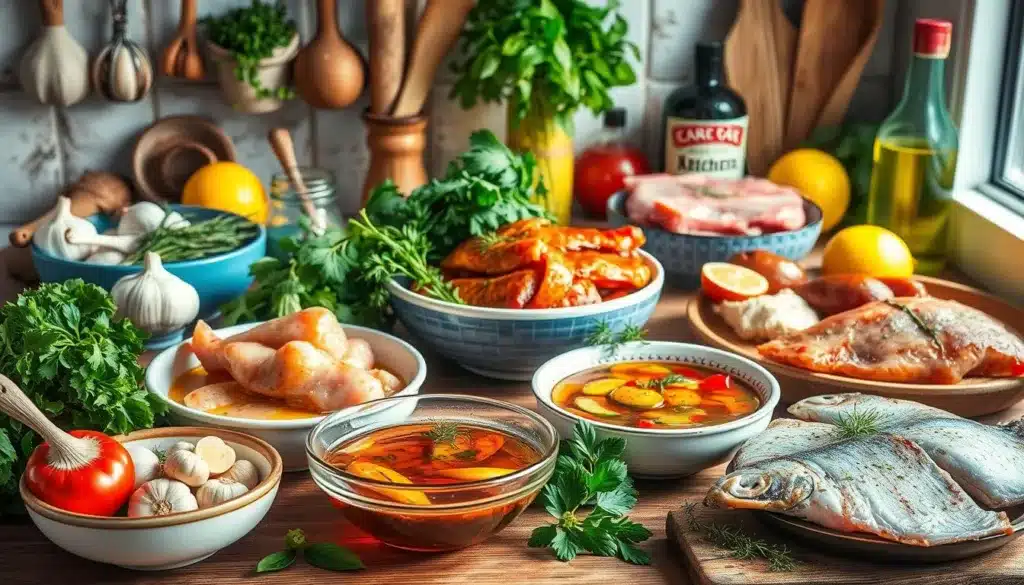
Learning how to marinate well means knowing what not to do. Many home cooks make mistakes that hurt the taste and texture of their food.
When you’re learning about marinades, there are a few big mistakes to watch out for:
- Over-marinating proteins, which breaks down muscle fibers
- Using too much acid that makes the texture mushy
- Not getting the salt right, which can dry out the meat
- Reusing marinades with raw meat juices
Getting the marinade just right is key. Too much acid can turn your meat into a mushy mess. You want a mix of 1 part acid to 3 parts oil, with the right amount of salt, herbs, and spices.
“Perfect marination is an art of balance and precision” – Culinary Experts
Keeping food safe is very important when you’re marinating. Never use marinades that have touched raw meat, as they can have bad bacteria. Always throw away at least half of the marinade to avoid contamination.
| Protein Type | Recommended Marination Time | Key Considerations |
|---|---|---|
| Chicken | 30 minutes – 24 hours | Avoid overnight for delicate cuts |
| Beef | 2-12 hours | Thicker cuts can handle longer marination |
| Fish | 15-30 minutes | Extremely sensitive to acid breakdown |
By steering clear of these common errors, you’ll get better at marinating. Your dishes will taste better, be more tender, and full of flavor.
Dry Rubs vs Wet Marinades
Every home chef has to decide between dry rubs and wet marinades when cooking meat. Knowing the differences between these techniques can really improve your cooking.
Dry rubs and wet marinades each have their own benefits for flavor and texture. Let’s look at what makes them special and when to use them.
Choosing the Right Technique
Dry rubs are loved by chefs for their ability to make a tasty crust and focus flavors. Unlike wet marinades, dry rubs don’t have liquid. Instead, they use herbs, spices, and salt.
- Dry rubs create a faster caramelized crust
- Marinades penetrate deeper into the protein
- Dry rubs work best for grilling and high-heat cooking
Balancing Flavor Profiles
The secret to a great dry rub is in its mix. A good mix might include:
| Ingredient | Percentage | Purpose |
|---|---|---|
| Salt | 40% | Enhances flavor |
| Brown Sugar | 30% | Adds sweetness |
| Black Pepper | 15% | Provides heat |
| Spices | 15% | Creates complexity |
Combining Techniques
Top chefs often mix dry rubs and marinades for the best taste. Use a dry rub a few hours before cooking, then add a light glaze or sauce after searing. This adds depth and complexity.
“The magic is in the balance – neither too wet nor too dry, but perfectly seasoned.” – Culinary Expert
Make sure the surface moisture is gone before searing for that perfect crust. Whether you pick a dry rub or a wet marinade, using quality ingredients is key to great flavor.
Marinating for Different Cooking Methods
Learning to marinate means knowing how cooking methods change your food’s taste and feel. You need to adjust your marinade based on whether you’re grilling, roasting, or pan-frying. This way, you get the best taste out of your food.
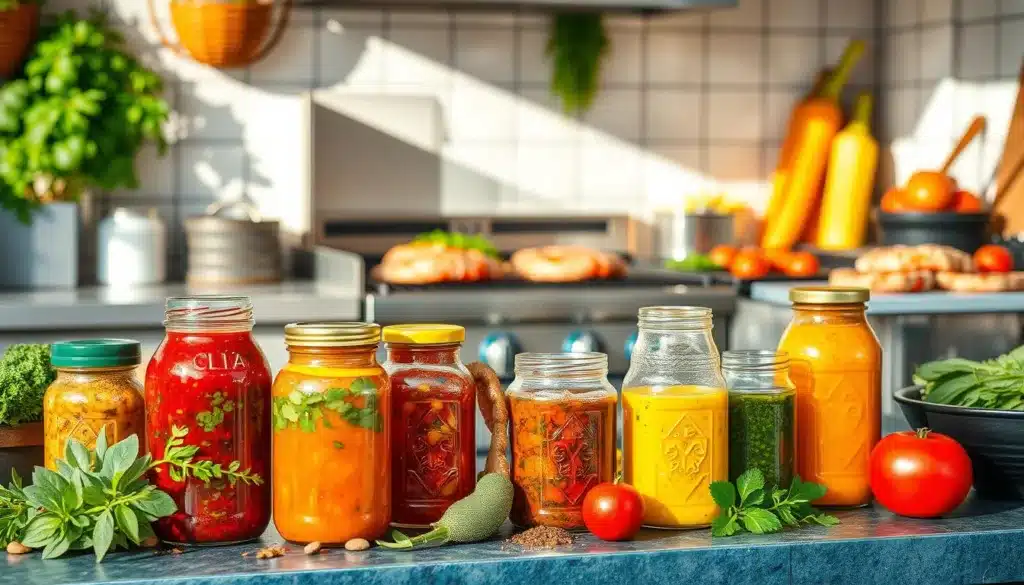
When you’re figuring out how to marinate well, keep these tips in mind:
- Grilling: Pick marinades with less sugar to avoid burning
- Roasting: Go for marinades with strong herbs and spices
- Pan-Frying: Choose marinades that make a nice crust
“The right marinade transforms ordinary ingredients into extraordinary meals.”
Cooking times and temperatures are key for good marination. Here’s a quick guide for the best results:
| Protein | Marination Time | Cooking Method | Internal Temp |
|---|---|---|---|
| Chicken | 2 hours | Grilling/Pan-Frying | 165°F |
| Fish | 15-30 minutes | Baking | 145°F |
| Beef | Up to 12 hours | Grilling | 145°F |
Keep in mind that marinades only penetrate a few millimeters into the meat. Your aim is to add flavor without changing the meat’s texture.
Cultural Marinade Variations
Exploring marinade recipes from around the world shows a rich mix of flavors. These techniques turn simple meals into amazing dishes. Each culture adds its own twist with special ingredients and methods.
Asian Marination Techniques
Asian cuisines are known for their complex marinades. They mix flavors in a way that’s both balanced and sophisticated. The Japanese miso soy marinade is a great example of this.
| Ingredient | Quantity |
|---|---|
| Soy Sauce | 1 Tbsp |
| Miso Paste | 1-1/2 Tbsp |
| Rice Vinegar | 3 Tbsp |
| Brown Sugar | 1/2 Tbsp |
| Mild Oil | 4 Tbsp |
Mediterranean Marination Approaches
Mediterranean marinades often include:
- Olive oil as a main ingredient
- Strong herbs like rosemary and thyme
- Citrus for a bright taste
- Garlic and fresh herbs for depth
Latin American Marination Methods
Latin American cuisine offers vibrant marinades. They use:
- Citrus-based marinades
- Chili pepper mixes
- Cilantro and cumin for flavor
“Marination is a journey of cultural flavors, transforming simple ingredients into extraordinary dishes.”
Start your culinary journey by learning about these marinade techniques. Each method offers a special way to improve your cooking. It brings global flavors right to your kitchen.
Equipment and Tools for Marinating
Choosing the right containers for marinating can change your cooking game. Both professional chefs and home cooks agree: the right tools are key. They help in absorbing flavors and keeping food safe.
- Non-reactive containers made of glass, ceramic, or stainless steel
- Resealable plastic bags with zip-top closure
- Vacuum sealers for maximum flavor infusion
- Shallow dishes with tight-fitting lids
- Digital meat thermometers
When picking containers, think about these important points:
- Size matters: Choose containers big enough to cover the meat fully
- Make sure they’re easy to clean
- Stay away from aluminum or copper, as they can react with acidic marinades
“The right container isn’t just about holding your marinade—it’s about maximizing flavor potential.”
Plastic bags have their perks for marinating. They save fridge space, ensure even coverage, and make cleanup easy. For those who love precision, vacuum sealers remove air for deeper flavor.
But remember, food safety is crucial. Always marinate in the fridge, not at room temperature, to stop bacteria growth. Use different containers for raw meats to prevent contamination.
Storage and Food Safety Best Practices
Mastering marinading techniques is not just about flavor. It’s also about keeping your food safe. Knowing how to marinate effectively means following key food safety guidelines. These guidelines help protect you and your loved ones from foodborne illnesses.
Temperature control is key when working with marinated foods. The danger zone for food temperature is between 40°F and 140°F. This is where bacteria grow fast. To stop bacterial growth, follow these storage practices:
- Always marinate foods in the refrigerator, not at room temperature
- Keep refrigerator temperatures at or below 40°F
- Limit marinating time to prevent bacterial development
- Use clean, sealed containers for marination
“Food safety is not an option – it’s a necessity in every kitchen.” – Food Safety Expert
Food safety is crucial. About 1 in 6 Americans gets food poisoning each year. This leads to 128,000 hospitalizations. To reduce bacteria, refrigerate perishable foods within two hours.
Here are some key safety tips for marinating:
- Never reuse marinades that have been in contact with raw meat
- Discard marinades after single use to prevent cross-contamination
- Use a food thermometer to verify internal food temperatures
- Store marinated foods in shallow containers for rapid cooling
By following these marinading techniques and food safety practices, you’ll make delicious meals. And you’ll keep your health safe.
Conclusion
Learning how to marinate can turn simple meals into amazing dishes. It’s all about finding the right mix of ingredients, timing, and science. Your kitchen becomes a place where you can play with flavors and techniques.
Marinating is more than just soaking food in liquid. It’s about using acids like lemon juice and tomato sauce to make meat tender and flavorful. The length of marinating also matters, with chicken needing 2 hours and beef up to 24 hours.
Don’t stop exploring once you learn the basics. Try different acids and understand how they work with proteins. With practice, you’ll make your cooking better and more exciting. It’s all about patience, paying attention, and enjoying the process of creating new flavors.
Start making your meals better, one marinade at a time. Your taste buds will love the journey of discovering new flavors.
Looking for more delicious recipes to try? Explore these amazing dishes on American Tasty:
- Red Lentil Soup with Warm Spices: A comforting, flavorful soup perfect for any season.
- Fishcakes and Scallops Stir-Fry Recipe: A quick and easy seafood dish with a savory twist.
- Chocolate Espresso Dacquoise: A decadent dessert that combines chocolate and coffee flavors.
- Crab Dip: A creamy, crowd-pleasing appetizer for any gathering.
- Pea Salad: A fresh, vibrant side dish that’s perfect for summer meals.
- Breakfast Lasagna: Start your day with a hearty and unique breakfast recipe.
- Pumpkin Soup: A rich, velvety soup that’s ideal for autumn evenings.
FAQ
What is the primary purpose of marinating food?
Marinating does two main things. It tenderizes meat and adds flavor. The mix of acids, oils, and seasonings softens the meat. It also makes the food taste great by soaking deep into it.
How long should I marinate different types of proteins?
The marinating time changes based on the protein. Fish and seafood need 15-30 minutes. Chicken can marinate for 2-8 hours. Beef or pork takes 4-24 hours.
But don’t marinate too long. It can make the meat mushy or “cook” it too much.
Can I reuse a marinade?
No, it’s not safe to reuse a marinade that touched raw meat. If you want to use it as a sauce, boil it first. This kills bacteria. It’s best to make a new batch of sauce.
What’s the difference between a dry rub and a wet marinade?
A dry rub is a spice mix you rub on the food. A wet marinade is a liquid the food soaks in. Dry rubs make a tasty crust for grilling. Wet marinades tenderize and flavor the food inside.
How do I prevent my marinated food from becoming too acidic?
Use acidic ingredients carefully. Don’t add more than 1/4 to 1/3 cup per cup of marinade. Don’t marinate delicate proteins too long. Mix oils, herbs, and seasonings with acids for a balanced flavor.
What are the best containers for marinating?
Use glass, ceramic, or food-grade plastic containers. Stay away from metal, especially aluminum or copper, as it can change the taste. Plastic bags are also good for marinating.
Can I marinate vegetables the same way as meats?
Vegetables need gentle marinating. They soak up flavors fast and can get soggy if marinated too long. Usually, 30 minutes to 2 hours is enough. Use light marinades with less acid to keep their texture.
Are there any ingredients I should avoid in marinades?
Don’t use too much salt or acidic ingredients. They can make meat tough. Also, be careful with pineapple or papaya as they can tenderize meat too much. Always mix your marinade ingredients carefully.
Join Our Community!
💬 Facebook: Stay updated with our latest recipes, cooking tips, and delicious inspiration. Join the conversation and share your creations with us on American Tasty’s Facebook page.
📌 Pinterest: Discover mouthwatering recipe ideas and save them for later! Follow our boards on American Tasty’s Pinterest for endless culinary inspiration.
✨ Why Join?
- Get exclusive recipes and updates.
- Share your food creations and inspire others.
- Connect with a community of food lovers like you!

